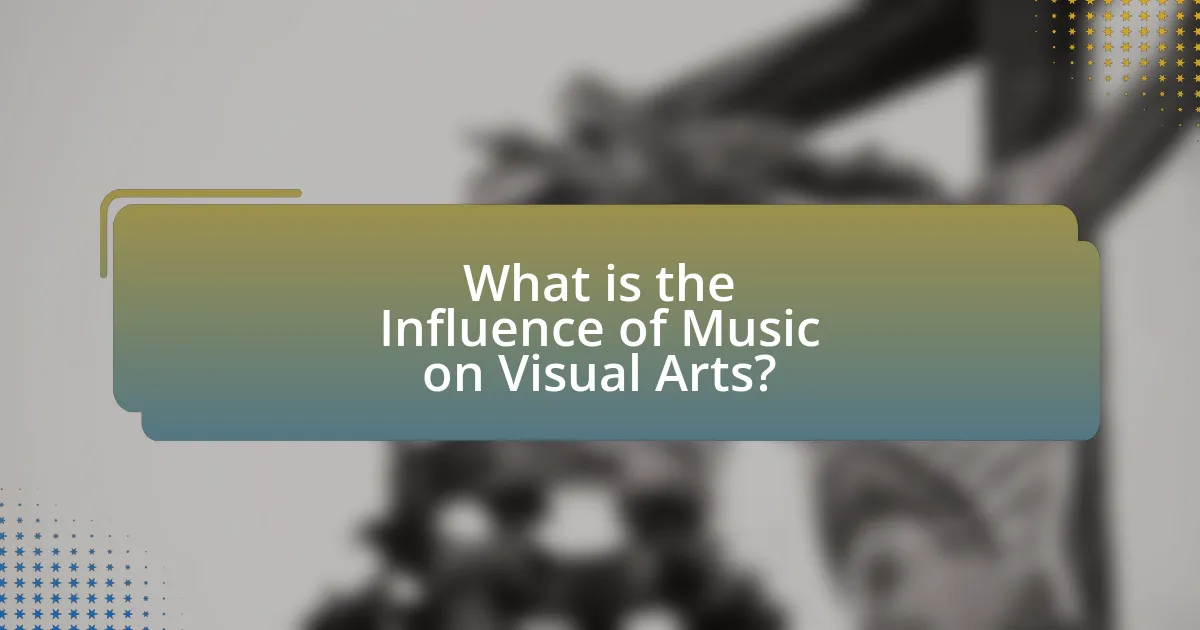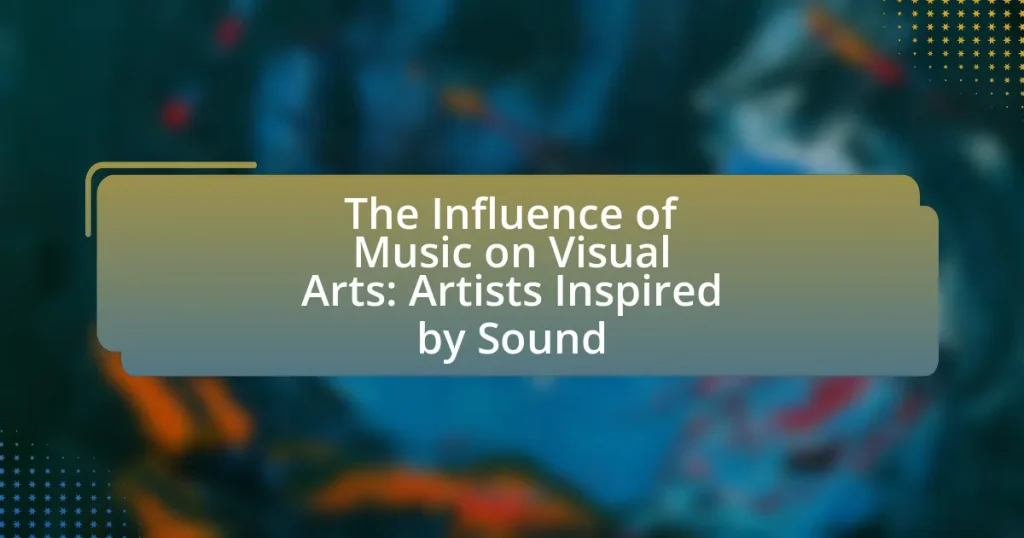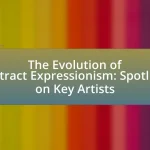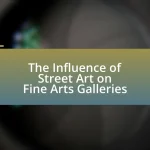The article examines the profound influence of music on visual arts, highlighting how sound inspires artists to explore themes, emotions, and concepts through their work. It discusses notable figures such as Wassily Kandinsky and Paul Klee, who integrated musical elements into their art, believing that color and form could evoke similar emotional responses as music. The article also explores various ways music impacts artistic expression, including emotional inspiration, rhythm, and thematic exploration, while providing historical contexts and examples of specific artworks that demonstrate this relationship. Additionally, it addresses the evolution of this influence over time and offers practical insights for artists on how to effectively incorporate musical inspiration into their creative processes.

What is the Influence of Music on Visual Arts?
Music significantly influences visual arts by inspiring artists to explore themes, emotions, and concepts that resonate with sound. For instance, artists like Wassily Kandinsky and Paul Klee incorporated musical elements into their work, believing that color and form could evoke similar emotional responses as music. Kandinsky, in his essay “On the Spiritual in Art,” argued that visual art could parallel the emotional depth of music, suggesting that both forms can transcend the physical world and connect with the viewer’s inner experience. This interplay between music and visual arts has led to the development of movements such as Abstract Expressionism, where artists sought to express feelings and ideas through non-representational forms, much like a musical composition.
How does music inspire visual artists?
Music inspires visual artists by evoking emotions and stimulating creativity, leading to the creation of artwork that reflects the themes and feelings conveyed in musical compositions. For instance, artists like Wassily Kandinsky believed that music could translate into visual forms, using color and shape to express the same emotional resonance found in sound. Research indicates that listening to music can enhance creative thinking, as demonstrated in studies where participants exposed to music produced more innovative visual art compared to those in silence. This connection between auditory and visual stimuli illustrates how music serves as a catalyst for artistic expression, enabling artists to explore and communicate complex emotional landscapes through their work.
What are the different ways music can influence artistic expression?
Music influences artistic expression in several ways, including emotional inspiration, rhythm and movement, and thematic exploration. Artists often draw emotional energy from music, using it to evoke feelings in their visual works, as seen in the abstract expressionist movement where artists like Jackson Pollock created pieces inspired by jazz music. Additionally, the rhythm and structure of music can guide the composition and flow of visual art, with artists like Wassily Kandinsky explicitly linking color and form to musical elements, believing that visual art could parallel musical experiences. Finally, music can provide thematic content, with artists interpreting lyrics or musical narratives into visual forms, as demonstrated by the works of artists like Robert Rauschenberg, who incorporated musical themes into his mixed-media pieces.
How do artists interpret sound through visual mediums?
Artists interpret sound through visual mediums by translating auditory experiences into visual forms, often using color, shape, and movement to evoke the essence of music. For instance, Wassily Kandinsky, a pioneer of abstract art, believed that colors and shapes could represent musical notes and rhythms, creating a synesthetic experience where visual art mirrors sound. This interpretation is supported by studies showing that visual art can elicit emotional responses similar to those experienced when listening to music, reinforcing the connection between auditory and visual stimuli.
Why is the relationship between music and visual arts significant?
The relationship between music and visual arts is significant because both forms of expression share a fundamental connection in evoking emotions and conveying ideas. This interplay allows artists to draw inspiration from musical elements, leading to innovative works that blend auditory and visual experiences. For instance, Wassily Kandinsky, a pioneer of abstract art, believed that colors and shapes could represent musical tones, demonstrating how music influenced his visual compositions. Additionally, studies have shown that synesthetic experiences, where individuals perceive sounds as colors or shapes, further illustrate the deep-rooted connections between these art forms. This significance is evident in various artistic movements, such as Futurism and Dadaism, where artists incorporated musical concepts to enhance their visual narratives.
What historical contexts highlight this relationship?
The historical contexts that highlight the relationship between music and visual arts include the Baroque period, where composers like Johann Sebastian Bach influenced artists such as Johann Friedrich Overbeck, and the Romantic era, which saw artists like Caspar David Friedrich draw inspiration from the emotional depth of music. During the 20th century, movements like Abstract Expressionism were significantly shaped by jazz music, with artists such as Jackson Pollock creating works that mirrored the improvisational nature of jazz. These contexts demonstrate how music has served as a catalyst for artistic expression, with specific examples illustrating the direct influence of musical styles on visual art forms.
How has this influence evolved over time?
The influence of music on visual arts has evolved significantly from the early 20th century to the present day. Initially, artists like Wassily Kandinsky and Paul Klee sought to translate musical concepts into visual forms, emphasizing color and rhythm as parallel elements in both disciplines. Over time, movements such as Abstract Expressionism in the mid-20th century further integrated musical influence, with artists like Jackson Pollock creating works that mirrored the spontaneity and emotional intensity of jazz music. In contemporary art, the relationship has expanded to include multimedia installations and digital art, where soundscapes and visual elements are combined to create immersive experiences. This evolution reflects a growing recognition of the interconnectedness of sensory experiences, as evidenced by exhibitions that feature both visual art and live music, illustrating the ongoing dialogue between these two forms of expression.
Who are some notable artists influenced by music?
Notable artists influenced by music include Wassily Kandinsky, who believed that colors and shapes could evoke musical sensations, and Paul Klee, whose works often reflect rhythmic qualities akin to musical compositions. Additionally, Jackson Pollock’s abstract expressionism was inspired by jazz music, particularly the improvisational style of artists like Charlie Parker. These artists demonstrate the profound impact of music on visual art, as evidenced by Kandinsky’s writings in “Concerning the Spiritual in Art,” where he articulates the connection between visual and auditory experiences.
What specific works demonstrate this influence?
Specific works that demonstrate the influence of music on visual arts include Wassily Kandinsky’s “Composition VII,” which visually interprets musical rhythms and harmonies, and Paul Klee’s “Twittering Machine,” inspired by the sounds of nature and music. Kandinsky believed that colors and shapes could evoke musical sensations, as evidenced by his writings in “Concerning the Spiritual in Art.” Klee’s work reflects his fascination with sound, as he often incorporated musical elements into his visual compositions. These examples illustrate the profound connection between auditory experiences and visual expression in art.
How do these artists incorporate musical elements into their art?
Artists incorporate musical elements into their art by using rhythm, harmony, and structure to influence their visual compositions. For example, Wassily Kandinsky, known for his abstract works, often drew inspiration from music, believing that colors and shapes could evoke similar emotional responses as musical notes. His painting “Composition VIII” reflects musical principles through its dynamic arrangement and use of geometric forms, paralleling the structure of a musical score. Similarly, Piet Mondrian’s use of primary colors and grid patterns in works like “Broadway Boogie Woogie” mirrors the rhythm and energy of jazz music, demonstrating how visual art can embody musicality. These artists effectively translate auditory experiences into visual forms, creating a dialogue between sound and sight.
How can we explore the connection between music and visual arts further?
To explore the connection between music and visual arts further, interdisciplinary collaborations between musicians and visual artists can be established. These collaborations can lead to innovative projects that combine sound and imagery, such as multimedia installations or performances that integrate live music with visual art displays. Historical examples include the work of Wassily Kandinsky, who was influenced by music in his abstract compositions, demonstrating that sound can inspire visual forms. Additionally, research shows that synesthetic experiences, where individuals perceive music as colors or shapes, can be studied to understand how auditory stimuli influence visual creativity. This approach can deepen our understanding of the interplay between these two art forms.
What are the common themes found in artworks inspired by music?
Common themes found in artworks inspired by music include rhythm, emotion, and abstraction. Rhythm manifests visually through patterns and movement, reflecting the tempo and dynamics of the music. Emotion is often conveyed through color choices and subject matter, capturing the feelings evoked by musical pieces. Abstraction allows artists to translate sound into visual forms, creating works that resonate with the essence of music rather than its literal representation. These themes are evident in the works of artists like Wassily Kandinsky, who believed that color and form could express musical qualities, and in the visual interpretations of jazz and classical music by contemporary artists.
How do these themes manifest in different artistic styles?
Themes of music influence manifest in various artistic styles through the use of rhythm, color, and abstraction. For instance, in Abstract Expressionism, artists like Jackson Pollock employed dynamic brushstrokes and vibrant colors to evoke the emotional intensity of music, reflecting the spontaneity and energy found in jazz. Similarly, in Impressionism, artists such as Claude Monet captured the fleeting effects of light and atmosphere, paralleling the ephemeral nature of musical compositions. The connection between sound and visual representation is further exemplified in the works of Wassily Kandinsky, who believed that colors and shapes could express musical qualities, leading to a visual language that resonates with auditory experiences. These examples illustrate how different artistic styles interpret and embody musical themes, creating a dialogue between sound and visual art.
What role does cultural context play in these themes?
Cultural context significantly shapes the themes of music’s influence on visual arts by providing the social, historical, and emotional backdrop against which artists create. For instance, the integration of jazz elements in the works of artists like Romare Bearden reflects the African American experience during the Harlem Renaissance, illustrating how cultural movements inform artistic expression. Additionally, the use of color and form in abstract expressionism, influenced by the rhythms of jazz, demonstrates how cultural context can dictate artistic techniques and themes. This interplay between music and visual arts is evident in the way artists respond to their cultural environments, making cultural context a crucial factor in understanding these themes.
What practical insights can artists gain from the influence of music on visual arts?
Artists can gain practical insights into color theory, emotional expression, and rhythm from the influence of music on visual arts. The relationship between music and visual art often manifests in the use of color palettes that evoke specific emotions, similar to how musical compositions convey feelings through melody and harmony. For instance, Wassily Kandinsky, a pioneer of abstract art, believed that colors correspond to musical notes, suggesting that artists can use music to inform their color choices and enhance emotional resonance in their work. Additionally, the rhythm found in music can inspire artists to create dynamic compositions that reflect movement and flow, as seen in the works of Jackson Pollock, whose drip paintings mimic the spontaneity and energy of jazz music. These insights enable artists to create more impactful and expressive visual narratives by integrating musical elements into their artistic processes.
How can artists effectively integrate musical inspiration into their creative process?
Artists can effectively integrate musical inspiration into their creative process by actively listening to music while creating visual art, allowing the rhythm, melody, and emotional content to influence their work. This method enables artists to translate auditory experiences into visual forms, fostering a deeper connection between sound and sight. Research indicates that engaging with music can enhance creativity; for instance, a study published in the journal “Psychology of Music” found that background music can improve creative performance by stimulating emotional responses and cognitive flexibility. By incorporating specific genres or pieces that resonate with their artistic vision, artists can create works that reflect the essence of the music, thus bridging the gap between auditory and visual art forms.
What techniques can be used to translate sound into visual form?
Techniques to translate sound into visual form include sonification, visual music, and data visualization. Sonification involves converting audio signals into visual representations, such as waveforms or spectrograms, allowing viewers to perceive sound characteristics visually. Visual music combines visual art and music, where artists create imagery that reflects the rhythm, melody, and dynamics of sound, often seen in works by artists like Oskar Fischinger. Data visualization techniques, such as using graphs or animations, can represent sound data, making it accessible and interpretable, as demonstrated in projects that visualize audio frequencies and patterns. These methods effectively bridge auditory and visual experiences, enhancing the understanding of sound through visual means.















